风俗习惯(中西方差异)英语版汇总
中西方文化差异_英语
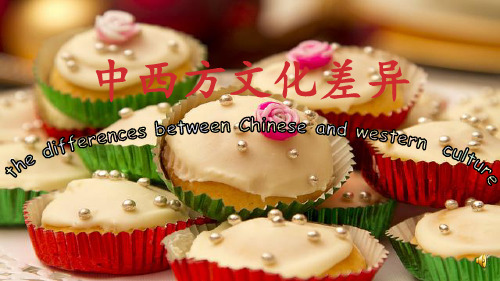
In China's cookery, achieves the acme nearly to the delicacy pursue, down to makes a living the Chinese to the overseas, take the restaurant as industry, has become us the basis which settles down and gets on with life in the world! It is a pity, our many traditional food must pass through overheated fries in oil boils with the long time soft fire dumpling, many nutrient contents lost in the processing process.
据西方的植物学者的调查, 中国人吃的菜蔬有600多种, 比西方多六倍。实际上,在 中国人的菜肴里,素菜是平 常食品,荤菜只有在节假日 或生活水平较高时,才进入 平常的饮食结构。
Therefore , in the final analysis between perceptual and rational difference. This kind of difference as if in changes along with the science development
fuzziness. As the matter stands the difference not was also too dis所ti以nc,t i归n 根th结e 底di还et是. 感 性与理性之间的差异。这 种差异似乎在随着科学的 发展而变的模糊。这样一 来在饮食上差异也就不太 分明了。
关于中外文化差异的中英对照文本

First of all, the way of eating. All human beings have certain needs. Our fundamental needs for things that keep us alive. This is the physiological need. All individuals must eat in order to survive. But what people eat, when they eat, and the manners in which they eat are all patterned by culture. No society views everything in its environment that is edible and might provide nourishment as food. Americans eat oyster but not snail. The French eat snails but not snake. We all have ideas about what kinds of food are good to eat. We also have ideas what kinds of food are bad to eat. As a result, people from one culture often think the food that people from another culture eat are disgusting or nauseating. Dislike is not the only reason why some culture will not eat a certain food. In some culture, certain foods are taboo. Sometimes the food taboos may be so strong that just thought of eating forbidden foods can cause an individual to feel ill.We can also find culture difference in way of bring up children ,treating the early, greeting each other, saying and spending money before other people do in everyday, but in some English-speaking countries, people do not agree with us. We Chinese may enjoy something that is not usually considered as edible by the English-speaking people. Generally we prefer to have thing hot and much emphasis on the taste. We eat from one plate when we are eating with others, and we like to seat one by one, and in the shape of a round. Onthe opposite, some English-speaking countries, most of the people like to seat in two rows, two people face to face. They have their own plate. On the aspect of table manners, there are many differences between Chinese and English-speaking people. For example, in some English-speaking countries, Bread plates are to the left of the main plate, beverage glasses are to the right. Salad fork, knife and soup spoon are far from the main plate than the main course knife, fork and spoon. When eating bread rolls, break off a piece before buttering. Use the knife only to butter the bread, not cut it. You should not start eating before your host does or instructs to do so. At large meals, it is considered okay to start eating once others have been served. When finished, place the knife and fork together at five o’clock with the fork on the left. It is considered rude to answer the telephone at the table. If need to take an urgent call, excuse self and go outside. Try to eat all the food you are served. But in China, the table manners are different. Chinese traditionally eat rice from a small bowl held in the left hand. The rice bowl is raised to the mouth and rice pushed into the mouth using the chopsticks. Some Chinese find it offensive to scoop rice from the bowl using a spoon. if rice is served on a plate, as is more common in the West, it is acceptable and more practical to eat it with a fork or spoon. The thumb must always be above the edge of the bowl. The host should always make sure the guest drinks are sufficiently full.One should notpour for oneself, but should offer to pour for a neighborhood. When your drink is being poured, you should say “thank you” and tap fingers on the table to show appreciation. When people wish to clink drinks together in the form of a cheer, it is important to observe that younger members should clink the edge of their drink below the edge of an elder to show respect.Secondly, the way of communication. Form birth to death, communication plays an integral part in our life.There are some language problems, including the different styles of using language such as direct, indirect; expansive, succinct; argumentative, conciliatory; instrumental, harmonizing; and so on. These different styles can lead to wrong interpretations of intent and evaluation of insincerity, aggressiveness, deviousness, or arrogance, among other.The misinterpretation includes nonverbal signs and symbols such as gestures, postures, and other body movements. It is a definite communication barrier. But it is possible to learn the meanings of these observable message, usually in informal rather ways.It is more difficult to understand the less obvious unspoken codes of the other cultures. Language, as the carrier of culture, is created during the process of human beings’ productive labor and serves as the tool of communication to convey the message between people. However, it has been endowed with magic and power in particular language acts.As the old saying goes,troubles come out of the tongue. Superstitious people think that the language itself can bring about fortune or misfortune so that taboos to restrict the use of language are created. Anyone who violates them will get punishment, whereas those who faithfully obey the restrictions of language taboo will get protection. Furthermore, linguistic taboos change with the development of society.The paper firstly analyzes the evolution of linguistic taboo. It is indicated in the paper that linguistic taboo exists in almost every aspect of people’s life and is a universal social phenomenon in China and Britain.Both Chinese and English cultures are in agreement about linguistic taboos such as pronunciation taboo, and vocabulary taboo. However, influenced by different cultural backgrounds, ideologies and the concepts of value, Chinese and English linguistic taboos also have differences, as is discussed in the paper from the aspects of taboo subjects, taboo numbers and names.At last, this paper puts forward two effective ways of avoid taboo, that is,using euphemism and having a good knowledge of the taboo culture. And this discussion would help English learners, improve their ability of cross-cultural communication and achieve better communicational effects. For example, during the feudal times, people were not equal to the rulers and were suppressed by their superiors.The distinction between the upper and the lower classes was also reflected in the evaluation of the language used by them respectively. The words ofupper class used were considered good and elegant while those used by the lower class were regarded as vulgar and indecent and should be avoided in the speech of ladies and gentlemen. In modern society, as a result of the development of science and technology, many natural phenomena are no longer mysterious. Human beings not only constantly improve their abilities to exploit the world where they are living through their great wisdom and knowledge, but also make efforts to explore the extraterrestrial world. Science has much more say in today’s society. Thereby, the superstitious elements in linguistic taboos decrease while those reflecting spiritual civilization increase.In short, by comparison, we can find that both Chinese and English communication reflect people’s psychology for good will, for safety and fortune and pleasantness.The Chinese and English people restrict their words and deeds through taboos, trying to keep a harmonious relationship between human and nature, or between people and society. They are a reflection of people’s pursuit of freedom and equality.首先,是饮食的方式。
中西方餐桌礼仪差异英语整理
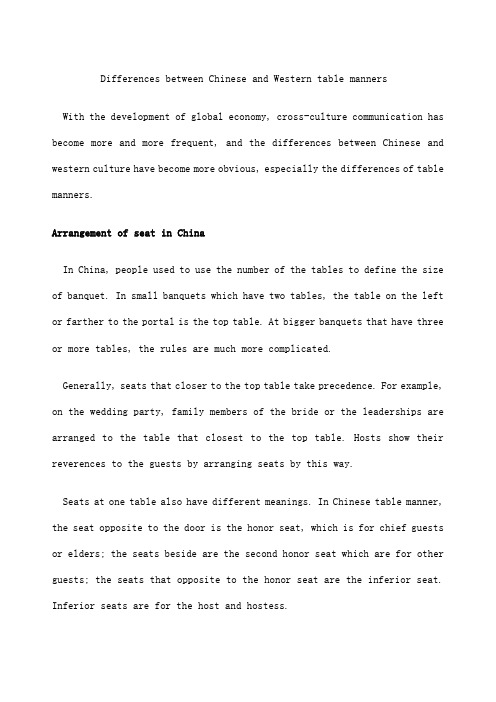
Differences between Chinese and Western table mannersWith the development of global economy, cross-culture communication has become more and more frequent, and the differences between Chinese and western culture have become more obvious, especially the differences of table manners.Arrangement of seat in ChinaIn China, people used to use the number of the tables to define the size of banquet. In small banquets which have two tables, the table on the left or farther to the portal is the top table. At bigger banquets that have three or more tables, the rules are much more complicated.Generally, seats that closer to the top table take precedence. For example, on the wedding party, family members of the bride or the leaderships are arranged to the table that closest to the top table. Hosts show their reverences to the guests by arranging seats by this way.Seats at one table also have different meanings. In Chinese table manner, the seat opposite to the door is the honor seat, which is for chief guests or elders; the seats beside are the second honor seat which are for other guests; the seats that opposite to the honor seat are the inferior seat. Inferior seats are for the host and hostess.So before the banquet, hosts should first invite the chief guest or elders to the honor seat, and then invite other guests to the second honor seat. Hosts sit down on the inferior seats after all the guests sit down. Arrangement of seat in WestWestern people prefer long table to round table when entertaining friends. The host and the hostess seat at both end of the table, while guests seat at other seats. The chief guest sits at the upper right side of the hostess, and the wife of the chief guest seats at the upper right side of the host. In China, left is honor and right is secondary. While in western, right is honor and left is secondary. The proper way to take the seat in western is to sit by the left hand. It is better not to walk out before the banquet is finished.Tablewares between China and WestChinese table wares involve chopsticks, small dish, bowl and glass. Chopsticks and spoon are always put together on the right hand of the plate. Toothpick and ashtray are also necessary.Chopsticks are the main table wares in Chinese food culture. It is impolite to use chopsticks to clean tooth, or pick other things that aren’t food. It is also bad manner to talk with chopsticks in hand.The right way to use spoon is: scoop the food, and wait for seconds to make sure that the soup will not splash out, and then move the spoon back. It is impolite to put the spoon in to mouth, or lick the spoon over and over again. In western meals , they use so much table wares with different kinds and sizes. the use of table wares also shows different food culture in different countries, the main table wares in western are knives, forks , spoons , glass and napkin.Knife is used to cut food and fork is used to carry food into mouth. during the dinner, you should put them on both sides of the plate, and knife and fork should be put in the way that looks like the Chinese word “八”.You can also use them in a way that handle knife in your right hand and fork in the left hand. Soup spoon is always put on the outermost right side, together with the knife. Dessert spoon is put together with dessert knife and fork.Different atmospheres at tableNoisy and quiet is the main different of table atmosphere between Chinese and western. Chinese table atmosphere always noisy and always the noisier the better. While western table atmosphere is quiet.. In China,people begin to talk at the time they sit down, and they would keep talking during the whole dinner. Everybody at the table talking,drinking, eating, and enjoying the pulsating atmosphere. Noisy atmosphere can reflect the guests’ happiness from their hearts.Westerners also talk at table, but they talk quietly and keep the voice at the stage that can only be heard. You can not make noises when drinking soup. Chewing with your mouth closed and do not making noises when eating. The way to finish eatingAt Chinese dinner table, after eating, the chopsticks should put orderly at the right side of the bowl, and leave after the host signals to leave. Hosts should signal after all the guests put down their chopsticks.At western dinner table, the ways to finish eating is to put the knife and fork together on the plate parallel, with the fork’s back side up and the knife’s edge inside.Through comparing the table manners of Chinese and Western countries and keeping pace with the changing world can be more meaningful to all people.。
中西方结婚习俗差别 英文版

中西方结婚习俗差别英文版中西方结婚习俗差别英文版奇酷7502014-09-25优质解答In China,surnames are always given first.A man named as Wang Xin,for instance,should be called as Mr.Wang,instead of Mr.Xin.In western cultures,Surnames are given last.东方人的姓在前,西方姓在后,名在前.A married woman always retains her maiden name.However,this is different in westerncultures where a married woman usually take the last name of her husband.中国人结婚后保留自己的姓,西方女人一般跟丈夫姓Asian grooms pick up their brides before the wedding starts while it is unlucky in western culture for the groom to see the bride before the wedding starts.亚洲新郎婚礼前会去接新娘,西方文化说的是新郎新娘在婚礼前是不能见面的,会倒霉.Asian weddings are often festive in a banquet hall filled with high-spirited activities and handing out money while western weddings are quiet often celebrated in a church or park.东方婚比较热闹,有很多礼仪,像是给钱什么的,西方婚礼比较安静,没有收钱的习惯一般,在教堂,公园等等地方举行asian brides traditionally wear red while western brides wear white carrying something new,something old,something blue,something borrowed.中方新娘传统是穿红色,西方传统穿白色,要携带一样新的东西,一样旧的东西,一样蓝色的东西,一样借的东西.小颜626mFp2014-09-25中国有哪些传统节日?各有怎样的传统习俗和文化内涵中国有哪些传统节日?各有怎样的传统习俗和文化内涵三角梅ㄣ60392014-12-04优质解答春节(Spring Festival)中国民间最隆重最富有特色的传统节日,一般指除夕和正月初一.但在民间,传统意义上的春节是指从腊月初八的腊祭或腊月二十三或二十四的祭灶,一直到正月十五,其中以除夕和正月初一为高潮农历正月十五日,是我国汉族的传统节日元宵节.正月为元月,古人称夜为"宵",而十五日又是一年中第一个月圆之夜,所以称正月十五为元宵节.又称为"上元节".按中国民间的传统,在一元复始,大地回春的节日夜晚,天上明月高悬,地上彩灯万盏人们观灯、猜灯谜、吃元宵合家团聚、其乐融融. 清明节古时也叫三月节,公历四月五日前后为清明节,是二十四节气之一.在二十四个节气中,既是节气又是节日的只有清明. 清明节是中国重要的传统民俗节日之一,2006年被列入第一批国家级非物质文化遗产名录农历五月初五,俗称“端午节”,端是“开端”、“初”的意思.初五可以称为端五.农历以地支纪月,正月建寅,二月为卯,顺次至五月为午,因此称五月为午月,“五”与“午”通,“五”又为阳数,故端午又名端五、重五、端阳、中天、重午、午日,此外一些地方又将端午节称之为五月节、艾节、夏节. 中秋节是我国的传统佳节,与春节、端午、清明并称为中国汉族的四大传统节日. 农历九月九日,为传统的重阳节.重阳节又称为"双九节""老人节"因为古老的《易经》中把“六”定为阴数,把“九”定为阳数,九月九日,日月并阳,两九相重,故而叫重阳,也叫重九,古人认为是个值得庆贺的吉利日子,并且从很早就开始过此节日. 帮你挑了这点..如果还想要少点你自己挑着写吧...一些不重要的可以删掉!中国的传统节日礼仪习俗有哪些中国的传统节日礼仪习俗有哪些TA002032014-09-28优质解答春节春节代表着新的开始与新的希望,春节是中国民间传统中最为隆重和盛大的节日.历朝历代,无论是达官显贵,还是贩夫走卒,所有的中国人都有把春节看作是喜庆团聚的好日子.春节,古称元旦.据民间习俗,从腊月二十四起到新年正月十五闹元宵止都称春节.现在春节的庆祝活动一般从大年三十(二十九)开始.春节期间,家家户户清扫一新,贴春联、贴年画、守岁、放鞭炮、拜年等活动丰富多彩.扫尘:每年从农历腊月二十三日起到除夕止,我国民间把这段时间叫做“迎春日”,也叫“扫尘日”.扫尘就是年终大扫除,北方称“扫房”,南方叫“掸尘”.每逢春节来临,家家产户都要打扫环境,清洗各种器具,拆洗被褥窗帘,洒扫六闾庭院,掸拂尘垢蛛网,疏浚明渠暗沟,到处洋溢着欢欢喜喜搞卫生、干干净净迎新春的气氛.办年货:一到腊月,人们都要上街采办过年的物品,买年画,准备过年的春联.吃团年饭:团年饭意为一家团圆.腊月的最后一天要全家团聚吃一顿丰富的年饭.凡家中在外地工作或学习的家人都会尽可能赶回家团聚.这顿饭要吃得欢欢乐乐,菜肴吃食也具有吉利的象征意义,如鱼(年年有余)、整鸡(大吉大利)、青菜(清洁平安)、年糕(年年高)等.吃饭时,不要说丧气的、不吉利的话,不能失手打破碗碟杯盏,不要碰翻椅凳,因为这些会被视为不吉利的征兆.守岁:除夕之夜,灯火通明,家人围坐一起畅谈,长辈要将事先准备好的压岁钱分给晚辈,“岁”与“祟”谐音,晚辈得到压岁钱就可以平平安安度过一岁.除夕之夜,在我国北方家家都要包饺子.鞭炮迎新:“爆竹一声除旧,桃符万户更新.”古代燃放鞭炮是为了驱鬼祛邪,而如今则表示节庆欢乐,鞭炮越响,来年家庭财源会越兴旺.拜年:新年伊始,人们走亲访友,登门拜年互致节日祝贺,联络感情.拜年的习俗各地并不相同,但一般初一上午不走亲访友.出去拜年要穿戴整洁.出门遇到熟人、朋友要恭贺新年,说些吉利话,即使是遇见平时与之开惯了玩笑的人也不能随便开玩笑.见到长辈要行拱手礼.走亲访友要携带礼物.过年时,招待宾客的食物有讲究,通常以谐音讨口彩,比如吃柿子苹果,喻意事事平安;吃年糕则意味着年年高升.春节期间,人们还经常走上街头,参加舞狮子、耍龙灯、踩高跷、逛花会等娱乐项目.春节期间也要注意喜庆有度.这一期间热闹的时候比较多,不应为了自己开心而打扰了邻居们休息.春节不仅要拜年,有时候也要恭喜人家喜迁新居.看看新房的格局,参谋一下崭新的家具,如果您是访客,也会有这样的“猎奇”心理.但参观前应该征得主人的同意,等待主人的邀请,而不要主动直接提出参观请求,令主人不好拒绝.如果受到主人邀请参观,也要跟在主人身后,不要自己去打开房间门,尤其是卧室和主卫的门.因为有很多城市都不允许燃放烟花,有的人也没有放鞭炮的喜好,所以过年送礼最好不要送鞭炮.元宵节农历正月十五是一年中第一个月圆之夜,叫元宵节,又称“上元节”或“灯节”.自唐朝开始,民间就有元宵之夜观灯的风俗.现在元宵节有很多节俗活动.吃元宵是元宵节最主要的活动.古时候人们把元宵这种食品叫汤圆、汤团或团子.元宵的形状是圆形,又含着一个“圆”字的同音字,象征着团圆、美满、吉祥、和睦的家庭,所以人们多取其意,这一天要吃元宵.灯会在夜间举行,一般从正月初十开始就行动起来,人人动手,家家户户扎花灯、点花灯,特别是到了元宵节的夜晚时分,更是举烛张灯,结彩为戏,供人观赏,所以元宵节又称“灯节”.在明清时,花灯的样式最为繁多,数不胜数.现在政府、民间都会组织大型灯会.端午节农历五月初五为端午节,又称端阳节、午日节、五月节、艾节、端五、重午、午日、夏节.相传爱国诗人屈原在农历五月初五这天怀抱石头投汨罗江自尽,两岸百姓知道后,纷纷划船打捞他的尸体,并向江中投放粽子,使鱼虾饱食后不吃他的尸体.此传说历代沿袭下来,演变成如今端午节吃粽子、赛龙舟的习俗.节日的习俗礼仪有:挂菖蒲、艾叶:民间特别是农村家庭,门窗上要挂菖蒲、艾叶,用以驱鬼辟邪保平安.虽然这是迷信,但因艾叶、菖蒲具有杀虫、驱寒、消毒之用,故这一习俗一直保持下来,城乡许多家庭都在这一日采集艾叶,以备常年家用.吃大蒜头、喝雄黄酒:端午节,家庭要备一桌丰盛于平日的饭菜,全家共享.这一餐习惯上要吃大蒜头煮肉,喝雄黄酒.大人会在不能喝酒的孩子额头上沾上雄黄,或画一个“王字”,去病消灾.这种习俗在现代城市已逐渐被人遗忘.吃粽子:端午节吃粽是我国民间长久盛行的习俗.早在1300多年前的唐朝,吃粽已经流行.在湖南岳阳、益阳一带,端午还兴吃麻花,当地把它称“油绞”,女婿去丈母娘家拜节,也要提一串麻花.据说,吃麻花也是为了纪念屈原.赛龙舟:当时楚人因合不得贤臣屈原死去,于是有许多人划船追赶拯救,借划龙舟驱散江中之鱼,以免鱼吃掉屈原的尸体.竞渡之习,盛行于吴、越、楚.佩香囊:端午节小孩佩香囊,不但有避邪驱瘟之意,而且有襟头点缀之风.香囊内有朱砂、雄黄、香药,外包以丝布,清香四溢,再以五色丝线弦扣成索,作各种不同形状,结成一串,形形色色,玲珑夺目.中秋节农历八月正好在秋季的中间,古人谓“仲秋”,八月十五又在“仲秋”之中,所以称“中秋”,恰逢此日又与月有关的“中秋节”就有了许多别称:“八月节”、“八月半”、“月节”、“月夕”,继而引申为以圆月为象征的“团圆节”.人们邀请亲朋好友,夜饮玩月,连回娘家的媳妇这天都必须返还夫家.中秋晚上,我国大部分地区有烙“团圆”的习俗,即烙一种象征团圆、类似月亮的小饼子,即“月饼”.饼内包糖、芝麻、桂花和蔬菜等,外压月亮、桂树、兔子等图案.祭月之后,由家中长者将饼按人数分切成块,每人一块,如有人不在家即为其留下一份,表示阖家团圆.重阳节农历九月九日,是我国传统的重阳节,又名重九节、登高节、菊花节、茱萸节.我国古代把九定为阳数,农历九月九日,月日并阳,两阳相重,两九相叠,故名“重阳”,又名“重九”.每到这一天,人们出游登高,赏菊花,饮菊花酒,佩茱萸,吃重阳糕.时至今日,一些地区仍保存着这种风俗.政府还把重阳节定为“敬老节”,向老年人表达敬意之情并帮助他们解决困难等.冬至与腊月冬至是我国的一个重要节气,时间是12月22日或23日.过了冬至,我国大部分地区将进入最寒冷的时期.俗话说:“冬至大如年.”古代,在这一天有祭天、祭祖、拜贺、食百味馄饨等习俗,今天人们也在这一天祭祀先祖.腊月为腊月初八,有吃“腊八粥”的风俗.西方国家的节日习俗与简介分享|2013-04-14 15:29匿名|浏览2127 次西方国家的节日习俗与简介,每个节日介绍100字左右,要不同国家的,每个国家3个左右的节日就好。
风俗习惯(中西方差异)英语版
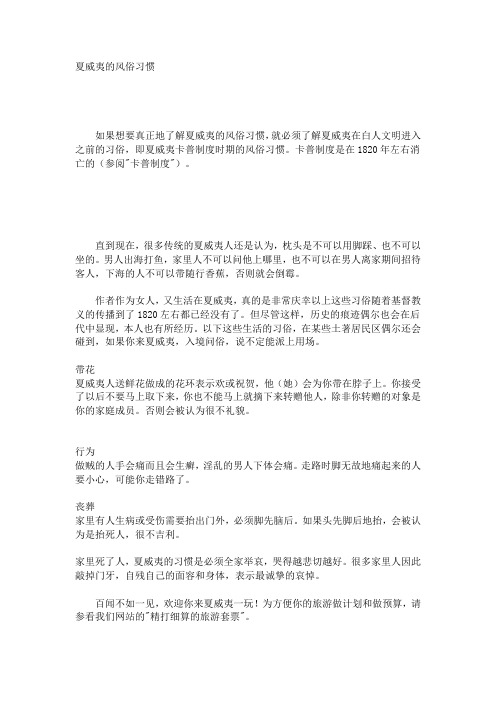
夏威夷的风俗习惯如果想要真正地了解夏威夷的风俗习惯,就必须了解夏威夷在白人文明进入之前的习俗,即夏威夷卡普制度时期的风俗习惯。
卡普制度是在1820年左右消亡的(参阅"卡普制度")。
直到现在,很多传统的夏威夷人还是认为,枕头是不可以用脚踩、也不可以坐的。
男人出海打鱼,家里人不可以问他上哪里,也不可以在男人离家期间招待客人,下海的人不可以带随行香蕉,否则就会倒霉。
作者作为女人,又生活在夏威夷,真的是非常庆幸以上这些习俗随着基督教义的传播到了1820左右都已经没有了。
但尽管这样,历史的痕迹偶尔也会在后代中显现,本人也有所经历。
以下这些生活的习俗,在某些土著居民区偶尔还会碰到,如果你来夏威夷,入境问俗,说不定能派上用场。
带花夏威夷人送鲜花做成的花环表示欢或祝贺,他(她)会为你带在脖子上。
你接受了以后不要马上取下来,你也不能马上就摘下来转赠他人,除非你转赠的对象是你的家庭成员。
否则会被认为很不礼貌。
行为做贼的人手会痛而且会生癣,淫乱的男人下体会痛。
走路时脚无故地痛起来的人要小心,可能你走错路了。
丧葬家里有人生病或受伤需要抬出门外,必须脚先脑后。
如果头先脚后地抬,会被认为是抬死人,很不吉利。
家里死了人,夏威夷的习惯是必须全家举哀,哭得越悲切越好。
很多家里人因此敲掉门牙,自残自己的面容和身体,表示最诚挚的哀悼。
百闻不如一见,欢迎你来夏威夷一玩!为方便你的旅游做计划和做预算,请参看我们网站的"精打细算的旅游套票"。
对外交往中的西方礼节与风俗习惯文化主要是指人类所创造的物质财富和精神财富以及社会化行为的积淀,它包括信仰、艺术、道德、风俗、习惯等,是一个复杂的总体,具有鲜明的时代性、民族性和地域性。
生活在某一地区的每个成员,都会自觉或不自觉地受到该地区文化的熏陶和影响,对该地区的文化有着天然的认同感,并形成共同的文化心理特征。
在对外交流和交往过程中,了解作为西方文化重要组成部分的西方礼节与风俗习惯可以帮助我们跨越由于文化障碍所造成的鸿沟,成功而迅速地达到交际的目的。
中西婚礼差异英文版

中西婚礼差异英文版Differences Between Chinese Marriage Custom and Western Marriage CustomAbstractThere are many procedures in Chinese marriage custom. The book propriety and ceremony, which records earliest wedding ceremony, says that marriage includes six etiquettes, namely, proposing, asking the name, asking for fortune, sending betrothal presents to the girl's family, discussing the date of marriage and meeting the bride. In western marriage, there are four procedures. They are proposal, changing surnames, choosing the day and holding the wedding. As the different religions, cultural origins, marriage concepts and geographies, there are many differences existing in the two kinds of marriage customs. In Chinese marriage custom, the matchmaker functions almost all the time and youths have no right to choose and women are not on an equal footing with men. By contrast, in western marriage custom, the priest functions and the youths have legal right to choose whom they want to marry and men and women are equal. There also exist common things in the two sides. They have been maintained for thousands of years. But in recent years (especially after the founding of modern China), people have tended to discard some of the details and advocate simplifiedmarriage procedures and wedding ceremonies.Key Words:Marriage custom; differences; reasons摘要中国婚俗有着许多的仪式。
中西方习俗差异
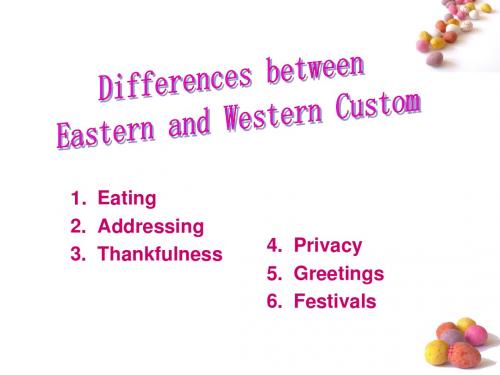
#
6. Festivals
East:The
Spring Festival Lantern Festival The Midautumn Day Dragon-boat Festival andso On
WEST:
Thanks giving day Halloween
and so on
Christmas
#
In addition, the differences between Chinese and western food culture is also reflected in the eating utensils. For example, Chinese people have meal with chopsticks while
#
4. Privacy
People from China do not regard it as asking personal affairs when they ask others name、age、 marital status、wages、personal life、belief and political points. It is regard as concerns. While the westerns will think you violate their right of privacy .
#
5. Greetings
In China, When people meet acquaintances or friends, we always say ,“Have you eaten yet?” What are you going to do?” In English, people often employ the following expressions to greet each other “Good morning/evening/afternoon. “Fine day, isn’t it? ”How is everything going?”, etc.
中西方饮食文化差异(中英对照)

Differences between Chinese and Western diet cultureCan you imagine the difference between the Western diet culture and the Chinese diet culture?First of all, I will introduce the general characteristics of Western diet culture.Western diet historyItaly cuisine is the originator of the Western diet culture, French cuisine is the Western diet culture king, American food is the Western diet culture upstart.Western food making skillsIn the production of the Western diet, they love the pursuit of perfection, but also attach importance to cooperation with a delicacy.Western diet varietiesThe famous dishes are Italy, French, American, German, Russian, etc. famous drinks include wine, coffee and black tea.Do you know,why there are so many differences between Chinese and Western diet culture?just like the menu,western diet is very tidy and serious,but the Chinese is multifarious.Now, you have known the difference of the menu,but do you know why diet has a strong regional character?Actually, western diet due to geographical characteristics, environment, customs, appears in cooking methods of differencesin eating habits. People in western countries like to eat pizza, while Chinese people like to eat dumplings.Differences between Chinese and Western culture makes a difference of Chinese and Western food culture.事实上,西方饮食由于地域特色、环境、风俗习惯,出现烹调方法不同程度的差异。
中西方餐桌礼仪差异英文
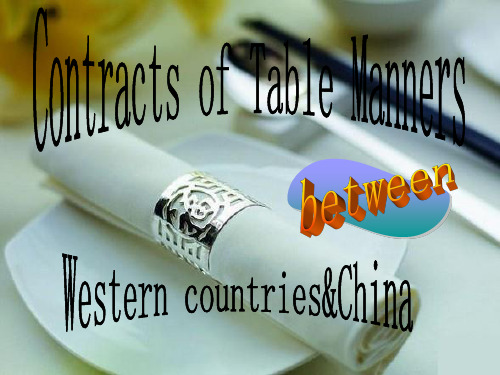
Arrival of time
China: don’t have certain standards about arrival time. Western Countries: time is money.
After the meal During the meal Before the meal
seating arrangement
eating manners
Western countries
❖ Don’t like smoking and drinking ❖ Seldom talking business affairs ❖ Private issues are forbidden
Don't Burp / Hiccup.
Impolite
Don’t make so much noise when you eat or drink.
Remember to say "That was good" to the one who made the dish upon leaving the table.
1.long table
2.guests of honor sit besides them
3.The more nearer to the host and hostess, the more important he or she is.
4.Host and hostess sit at both ends
Advocate freedom and consider that it is very rude and impolite to have dinner with noise
eating manners
中西文化习俗
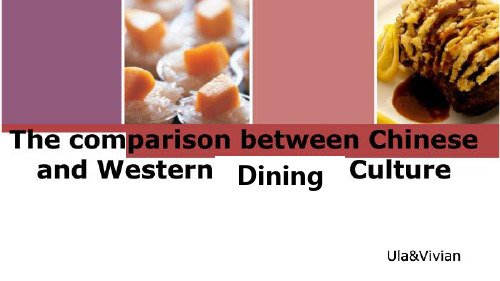
2、tableware
In general, only relatively simple Chinese dishes cups, plates, bowls, plates, chopsticks, spoons and other types. The West divided cups and plates knife and fork spoon, knife divided into edible knife, fish knife, meat knife,butter,knife,fork fruit knife and fork into edible, harpoon, lobster fork. Cups, mugs of porcelain and equipped with small dishes,
Dining etiquette
1、the time to attend
Time diversification mode Chinese people prefer 'late'. Often after a specified time and a half hours to reach, the owner seems to have already mentally prepared, usually arrange some other programs in this' waiting 'time, such as playing cards, drink tea, chat, so that some of the' first 'guests spend their time. For this 'late' phenomenon used to both host and guest, do not see it as a kind of contempt for the host to offer or impolite. Have a predetermined time to start a variety of activities in Western countries, being late is rude, formal banquet requirements arrive, who after less than ten minutes, it will be regarded as decency, is the owner and other guests are not respect
中西传统习俗对比(英文版)
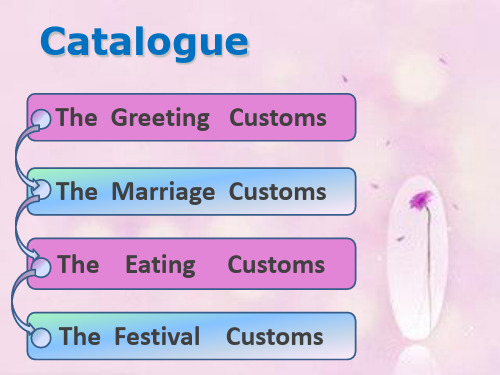
Betrothal letter(聘书)
Gift letter(礼 书)
Birthday matching (问名) Picking a wedding date(请期)
Wedding letter (迎亲书)
Presenting betrothal gifts(纳吉) Wedding ceremony (亲迎)
•The Mid-Autumn festival •The double ninth festival
Western
wedding veil 婚纱
Priest牧师
Floats花车
The Eating Customs
chopsticks
knife and fork
CHINA chopsticks
The dishes are placed the table and everyone share them together Hosts like to put food into the plates of their guests
Proposing (纳彩)
Presenting wedding gifts(纳征)
In Western the bride always in her white wedding gown and their wedding will be host in a church .
China
chaplet and official robes 凤冠霞帔 woman matchmaker 媒婆 bride‘s sedan chair花轿
Hug
Kiss the cheek
In China The bride and bridegroom would in red . Because we believe the red color represents lucky. And the wedding would be host in the bridegroom’s house
中西方传统节日文化差异英语PPT(1)
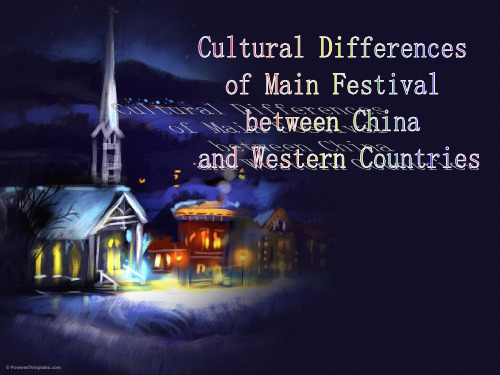
• The festivals in( China )mainly stem
from seasons and solar periods, which are closely related to agriculture.
• The festivals in(Western
)
generally stem fcroomunretlrigiioensand its
The Culture Differences and Blending between China and Western Countries in the View of Traditional Festivals Abstract There are aspects of differences between Chinese and Western cultures. Traditional festivals are one of the important differences.
red
white
With the development of the world exchanges have become more frequent and the development of science and technology, in international exchanges, we are faced with unfamiliar cultures and ways of thinking, life habit and behavior way and we be totally different people, in the process of interaction with the inevitable cultural conflicts.
中西方传统节日文化差异英语
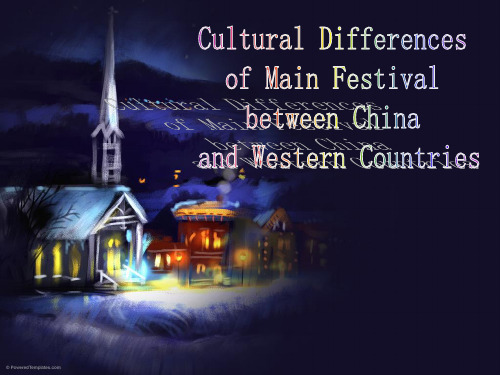
( Chinese)tend to focus more attention
on eating and drinking.
• When celebrating the festivals, the
(Westerner ) tend to put more asttention to the seeking of pleasure and
entertainments.
eating and drinking the seeking of pleasure and entertainments
The difference of festival diet characteristics
• ( Chinese)traditional festival diet tends
• The festivals in( China)mainly stem
from seasons and solar periods, which
are closely related to agriculture.
• The festivals in(Western
)
generally stem fcroomurneltigriioensand its
Today, we will discussion the differences and blending between Chinese and Western cultures through traditional festivals.
The difference of origin and formation
to be emotional, pay attention to color, flavor, smell and taste. Particularly festive food, each festival has to distinguish between different food of other festivals.
中西方风俗习惯差异英文版

1 two kind of different diet idea
Chinese: Flavor Western: Rational diet idea
2 China and west diet object’s difference
China: corn, noodles,vegetables,some meat West: meat,milk
Diet ways
Chinese put into practice Gather Dining System(集体共享制). The west put into practice individual Dining System(个人分享制).
Dable etiquette difference
Then, Bunni Creole town residents and tens of thousands of volunteers all able to take advantage of the water tap is opened entirely, to invest in another battle - sweep the streets. About an hour later, the square and the streets were swept clean again, Bunni Creole town resumed usual quiet.
table etiquette difference
the arrangement of seats
reflection of cultural difference
classification
china: harmonious unified
中西方文化的不同中英文对照

The Differences between Chinese and
western Culture
Diet
For one thing, Chinese and Westerners are different concepts in the diet. Chinese people are focus on the taste. They pursue all the Color, flavor and taste. But Western concept of rational diet. They pursue nutrition and they absorb Calorie and protein .Chinese people choice food very carefully. They only use fresh material in order to make delicious food. Western country like English or American, they don't have fresh food because they buy their food from supermarket which only sells stored materials. Chinese have a lot of ideas and techniques for cooking. For example, We can cook a chicken in over ten ways and people can taste all them with relish. Western people do not have many skills for cooking, mostly they only boil, steam and bake the food.
关于各国风俗的英语ppt展示
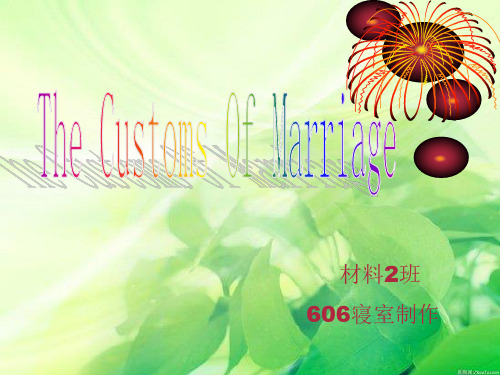
注:印第安人的岩画。 据说描述了一场婚礼
Indian wedding with a strong ethnic color.(浓厚的民族色彩)
婚礼的主持人是酋长和两位长老,根据印 第安人传统习惯,新郎婚前要设法猎获一头 糜鹿,用鹿肉加野米熬成汤,婚礼上分给大 家喝。按照古老惯例,印第安人婚礼上吃玉 米饼时,还应吃烤野牛肉,但今天的野牛成 为保护动物,所以许多人婚礼上的烤野牛肉 便用美国的”肯德基炸鸡”代替了。
婚礼可以隆重,也可以简约,没 有攀比,量力而行 )
美国的婚礼习俗,“something old, something new, something borrowed, something blue”。
something old 某样东西是旧的,象征着新娘的家庭和过 去。
something new 某样东西是新的,象征新的生活。 something borrowed某样东西是借来的,通常是指要从 已婚的幸福夫妇那里踩踩气、借借光。 something blue某样东西是蓝色的,表示纯洁纯真的 爱情(purity, fidelity and love),就像圣
母玛利亚一直穿着的蓝色长袍一样。
Over time this has changed from wearing a blue dress to wearing just a blue band around the bottom of the bride's wedding dress to modern times where it is commonplace for the bride to wear a blue garter. silver sixpence最后要在左鞋子里放 六便士的银币,表明财富与幸运会源源不断 地到来。
【优】风俗习惯差异英文PPT资料
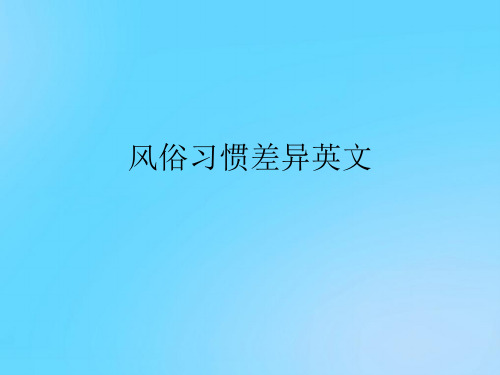
Chinese use chopsticks when they have meal.
While the foreigner use forks and knives when they have meal.
Difference
Chinese like cooking a lot of delicious dishes,then we set up tables,put the dishes on the tables,sit together,and taste the dishes together,we don’t eat with individual plates.
In Western the bride always in her white wedding gown and their wedding will be host in a church.
2.The Eating Custom:
DathnCfsuSisedtohmteoieopCncadanlehhm,ieknseiensgesodea,stfsn,snspzedtuatoeothltntaaerahgpmdatzoeseWonri,,dedfrsesiiobtdtrsrueigitaeocraeesnigemgraesninelasrtedssaffrooopnsabooltenerddade.opfaflopdeoizdz.a
you liked it. it especially you.”
I cook for
are not very tasty.”
4.the Festivals Customs:
In Western countries,people eat them with vegetable salad,they eat with drinking(water or juice),and they eat with separate plates.
- 1、下载文档前请自行甄别文档内容的完整性,平台不提供额外的编辑、内容补充、找答案等附加服务。
- 2、"仅部分预览"的文档,不可在线预览部分如存在完整性等问题,可反馈申请退款(可完整预览的文档不适用该条件!)。
- 3、如文档侵犯您的权益,请联系客服反馈,我们会尽快为您处理(人工客服工作时间:9:00-18:30)。
夏威夷的风俗习惯如果想要真正地了解夏威夷的风俗习惯,就必须了解夏威夷在白人文明进入之前的习俗,即夏威夷卡普制度时期的风俗习惯。
卡普制度是在1820年左右消亡的(参阅"卡普制度")。
直到现在,很多传统的夏威夷人还是认为,枕头是不可以用脚踩、也不可以坐的。
男人出海打鱼,家里人不可以问他上哪里,也不可以在男人离家期间招待客人,下海的人不可以带随行香蕉,否则就会倒霉。
作者作为女人,又生活在夏威夷,真的是非常庆幸以上这些习俗随着基督教义的传播到了1820左右都已经没有了。
但尽管这样,历史的痕迹偶尔也会在后代中显现,本人也有所经历。
以下这些生活的习俗,在某些土著居民区偶尔还会碰到,如果你来夏威夷,入境问俗,说不定能派上用场。
带花夏威夷人送鲜花做成的花环表示欢或祝贺,他(她)会为你带在脖子上。
你接受了以后不要马上取下来,你也不能马上就摘下来转赠他人,除非你转赠的对象是你的家庭成员。
否则会被认为很不礼貌。
行为做贼的人手会痛而且会生癣,淫乱的男人下体会痛。
走路时脚无故地痛起来的人要小心,可能你走错路了。
丧葬家里有人生病或受伤需要抬出门外,必须脚先脑后。
如果头先脚后地抬,会被认为是抬死人,很不吉利。
家里死了人,夏威夷的习惯是必须全家举哀,哭得越悲切越好。
很多家里人因此敲掉门牙,自残自己的面容和身体,表示最诚挚的哀悼。
百闻不如一见,欢迎你来夏威夷一玩!为方便你的旅游做计划和做预算,请参看我们网站的"精打细算的旅游套票"。
对外交往中的西方礼节与风俗习惯文化主要是指人类所创造的物质财富和精神财富以及社会化行为的积淀,它包括信仰、艺术、道德、风俗、习惯等,是一个复杂的总体,具有鲜明的时代性、民族性和地域性。
生活在某一地区的每个成员,都会自觉或不自觉地受到该地区文化的熏陶和影响,对该地区的文化有着天然的认同感,并形成共同的文化心理特征。
在对外交流和交往过程中,了解作为西方文化重要组成部分的西方礼节与风俗习惯可以帮助我们跨越由于文化障碍所造成的鸿沟,成功而迅速地达到交际的目的。
一、西方礼节同一文化背景下的人们具有共同的语言、风俗和习惯,形成了共同的思维方式、行为方式,道德规范和价值观念,在很大程度上用同样的方式来解释世界;而不同文化背景的人们由于所处的社会制度、民族传统、地理环境、价值观念、生活方式、思维方式、行为方式等方面的差异,在交际中就有着各具个性的语言模式、文化模式和交际模式,这种模式由于产生的背景不同,有时会出现截然的反差和根本的对立,常常具有不可移易性和不可通约性。
由于历史、地域等原因,中西文化差别较大,这种差异在日常交际的语言方式和礼节上主要有如下表现:1、称呼和问候中西文化在称谓上的差异较大。
西方称谓不拘礼节,多用名字相称,不仅兄弟姐妹间如此,即时对长辈和师长,也有直呼其名的,这与中国文化中长幼有序的称谓习惯完全不同;汉语中的“老”是对人的尊称,而英语中“old”却是“u seless”(衰老、不中用)之意,十分忌用;再者,汉语中常常将职业作为称谓,如称张局长,李主人,王老师等,英语中却只说:Mr.Zhang,Mr.Li,Miss Wan g等。
中国人见面打招呼时,常常问对方“吃了吗?”“去哪里?”“忙什么呢?”等,而西方人听到类似问候,会感到别扭、不快甚至恼怒。
如果一个西方人听到有人问他:Have you eaten?(吃了吗?)马上就会有两种反应:一是认为对方想请他吃饭,二是会想,I am not poor.I have money.(难道我连吃饭的钱也没有了吗?);如果听到有人问他:Where are you going会回答:It`s none of your business.(与你无关。
)与中国人不同,西方人打招呼时,常会说些Hi,Good morning,Hello!之类的客套话,从不打听别人的隐私。
2、赞扬和赞赏中国人对待别人的赞美常常表现得过分谦虚,甚至故意“否认”对方的赞誉。
如中国人听到别人说:“这件衣服真漂亮,非常适合你”时,马上就会说:“你过奖了,一点不漂亮,很便宜”等,若西方人听到别人的赞美,会感到快活、认同并致谢。
如果一位西方女郎听到别人说:“You are so beautiful.”(你太美了)定会愉快地回答:”Thank you.It`s so good.”相反,如果公开赞美一位中国女子,则会被认为是轻佻、无理或者流氓行为。
3、邀请和道别中国人受到别人邀请时,即使很乐意前往,也会半推半就,假意推辞一番,这一举动常常让崇尚直率的西方人感到难以琢磨。
如一位西方人(Westerner简称:W)邀请一位中国人(Chinese简称:C)共进晚餐,常会出现类似下面的对话。
W:Will you come to dinner with me?(共同进餐好吗?)C:May be I will.(或许吧。
)W:Will you come or not?(行不行啊?)C:I will try my best.(我尽量吧。
)如果这位西方人对中国文化一无所知,就会进一步逼问:“Please tell m e,yes or no.”(告诉我,到底行不行?)我们了解了西方国家的礼仪习惯,就应该明确地答复:“Yes,I will.”或“Sorry,I can`t.”,以免引起不快。
客人离开时,中国人习惯于将客人送到门口说“慢走”、“走好”等,如果按照同样的习惯对西方人说:“Go slowly ”“Take care”等,他们会感到很恼火“I am strong enough,why should go slowly?”(我身体很好,为什么要慢慢走呢?)另外,中国人道别时十分干脆,通常会看看表说:“我该走了。
”这种道别方式会令西方人感到吃惊。
西方人的习惯是提前十分钟左右表示要离开的打算,说些:“It has been a pleasure seeing you again,but I have t o attend a meeting at 10”(又见到你太好了,但我必须在10点钟开个会。
)之类的话。
4、礼尚和往来中国人自古以谦谦君子而自居,在送礼时常常会说:“这不是特地买来的,我们还多着呢。
”或“礼物菲薄,略表心意。
”等,受礼人则常说:“我们这有,不用您破费”等,而西方人在送礼时,则习惯上说:“这是我特意为你挑选的,是名牌”等,受礼人则会说:“这正是我所需要的,太美了,谢谢你”等。
实际上,西方人并不太在意礼物的金钱价值,只要是精心挑选的,哪怕是一双袜子都会令对方感到满意,但如果以此来对待国人,却往往会有“小气”之嫌。
5、隐私和禁忌隐私在西方倍受重视,中国人谈话时通常爱询问对方的年龄、婚姻、工作、收入、身高、体重等,以示关心和爱护,而这些话题却正是西方人的禁忌;再者如到西方人家中做客,切忌随便走动查看,更不兴问房价、装修等情况,甚至想看一下桌上的报纸、书刊或上卫生间等,都要事先征得主人的同意方可。
以上种种礼节差异的事实说明,在跨文化交际中,文化沟通是顺利交际的重要前提和根本保证,如果囿于本民族文化长期积淀的交际模式去交往,不必要的误解和误会是难以避免的。
二、风俗习惯风俗习惯也是文化的一个重要组成部分,了解一些有趣的西方风俗及其渊源,对于探索西方深厚的文化底蕴和解析西方所特有的社会文化现象,顺利架起东西方沟通的桥梁,具有十分重要的意义。
1、绅士风度展示中国素称礼仪之帮,汉语中有“礼多人不怪”之说,无独有偶,英语中也有“A gentleman is a gentleman anywhere and at any time.”与之相呼应。
然而有时,此之礼并非彼之礼,彼之有理也许为此之失礼。
比如说国人待客,主人明明精心准备了丰盛的菜肴却偏偏要说“家常便饭,请将就”以表客套有理。
然而,将此做法用于西方客人身上则适得其反。
主人的客套有理往往因客人难以领会而使其诚意受到怀疑:既然是家常便饭,何以用来招待客人?而主人的热情有理又往往使客人有“被强迫”之感。
女士优先是绅士风度的最好体现。
在西方,尤其是在英国,男士总是很主动、很乐意地为同行的女士让座、开门等,当共同进餐时,男士肯定会先拉出椅子,请女士入座后自己才坐下,如中途有女客人进来,男士也要首先起立以示欢迎,这些都是绅士风度的具体展示。
但近年来,随着女性自主意识的增强和女权运动的高涨,许多妇女认为这些做法在一定程度上存在着性别歧视。
曾经有人戏虐地说:如果一个小女人自己连门都不会开,其工资报酬不及男性的60%也就不足护的一种。
英语词组working girl至今仍被当作妓女讲就是最好的例证。
2、3、时尚休闲娱乐汉语中有“无以衣帽取人”,之说,英语中也有几乎完全一样的“Never j udge from appearance”然而衣帽能传达的丰富信息仍是不可否认的。
上世纪60年代,越战的残酷现实威胁着美国青年。
对政府及一切传统观念的怀疑和不满情绪膨胀,导致了Hippie精神的流行。
无数年轻人加入到了大布遮体、蓬生须发的行列之中。
他们要逃离文明的现代都市,群居于荒郊野岭之中。
嬉皮士们丝带束发,原始的珠串做项链,男人戴耳环和手镯,常常数万人佩花集会相聚。
正如嬉皮士代言人约翰.列侬在歌中唱的那样:“所有这些都是在说:给和平一次机会。
”70年代,现代都市的冷漠和资本经济对人的漠视首先刺激了敏感的年轻人。
在完全是年轻人的艺术形式——摇滚乐当中开始出现了大量冷漠、恐怖的形象,从歇斯底里的嘶叫和愤怒,到几乎没有形式的歌。
许多年轻人开始模仿那些被称为Punk风格歌星们的装扮。
当那些留着鸡冠状、针状发型、脸上涂着可怖的油彩,穿着金属一样衣服的年轻人出现在人群当中的时候,他们要表达的是赤裸裸的内心世界。
而进入80年代,当那些住豪宅、开名车、着名装的Yuppie(雅皮士)出现的时候,我们不得不承认,美国经济有了巨大的发展。
许多的年轻人在新兴的技术性职业中找到了天地,收入丰厚,社会地位高,他们要尽情地享受现代文明所带来的丰硕成果。
90年代刚刚开始,代表着美国计算机产业中心的西雅图便出现了令新一代青年心仪的新的摇滚乐形式和文化:Grunge。
其代表摇滚歌星Kurt Cobain从不穿西服,只穿T恤和衬衣,穿破了洞的宽牛仔裤,从不用洗洁剂洗头洗脸。
没有悲也没有乐。
当Cobain饮弹自杀后,数以万计的青年在烛光中为他的遗言而热泪长流:“我已经没有快乐了,与其湮灭生,不如迸发死。
”衣着和娱乐固然不能说明一个人的什么,可当它试图说明什么的时候,却能说明得非常深刻。
4、5、中国人爱酒,上至官显贵,下至市井平民,岁月悠悠,孕育了令国人自豪的酒文化。
当然,这里的酒多是由高粱经传统工艺酿制而成的“白酒”。
欧洲的葡萄酒传人中国大概是和天主教传人中国同时发生的,最初的中国教徒们大部分来自于上流社会,他们认可并接受了部分的西洋文化,闲来无事时,品一两杯洋教士带来的葡萄酒自然就不稀奇了。
